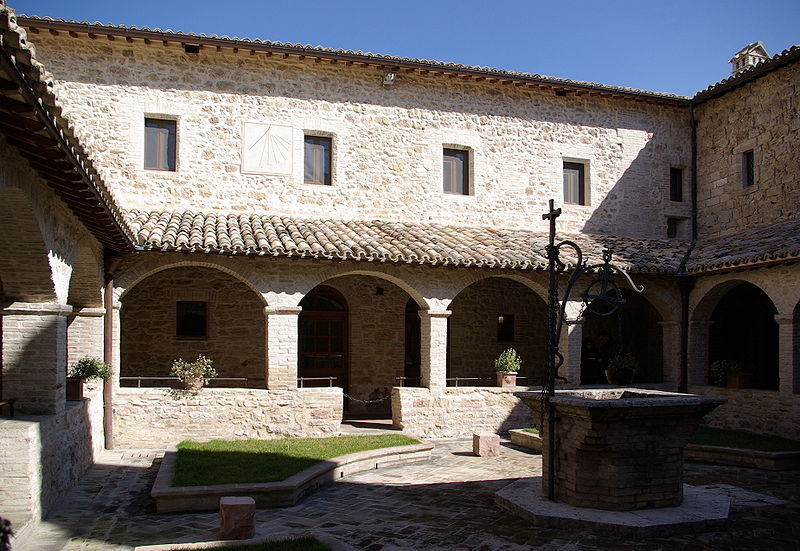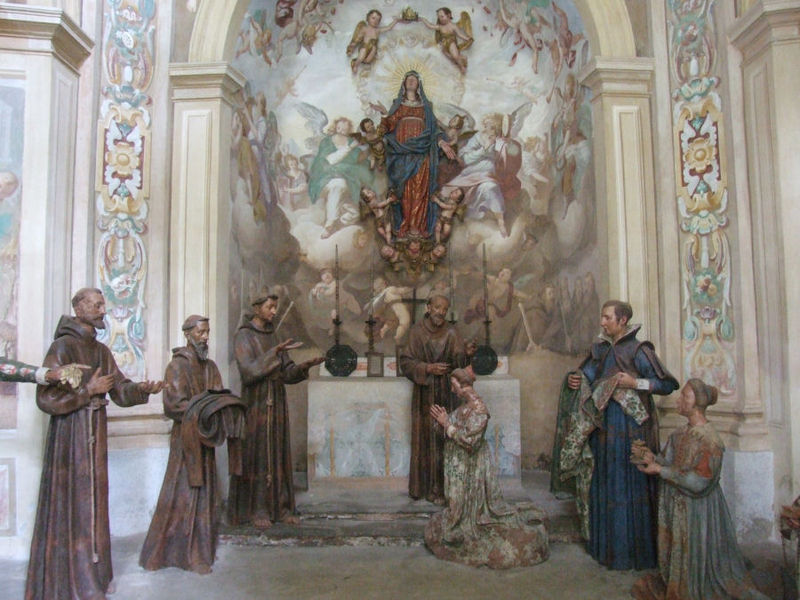
On a certain morning in 1208, probably 24 February, Francis was hearing Mass in the chapel of St. Mary of the Angels, near which he had then built himself a hut; the Gospel of the day told how the disciples of Christ were to possess neither gold nor silver, nor scrip for their journey, nor two coats, nor shoes, nor a staff, and that they were to exhort sinners to repentance and announce the Kingdom of God. Francis took these words as if spoken directly to himself, and so soon as Mass was over threw away the poor fragment left him of the world’s goods, his shoes, cloak, pilgrim staff, and empty wallet.
At last he had found his vocation. Having obtained a coarse woolen tunic of “beast color”, the dress then worn by the poorest Umbrian peasants, and tied it round him with a knotted rope, Francis went forth at once exhorting the people of the country-side to penance, brotherly love, and peace. The Assisians had already ceased to scoff at Francis; they now paused in wonderment; his example even drew others to him. Bernard of Quintavalle, a magnate of the town, was the first to join Francis, and he was soon followed by Peter of Cattaneo, a well-known canon of the cathedral. In true spirit of religious enthusiasm, Francis repaired to the church of St. Nicholas and sought to learn God’s will in their regard by thrice opening at random the book of the Gospels on the altar. Each time it opened at passages where Christ told His disciples to leave all things and follow Him. “This shall be our rule of life”, exclaimed Francis, and led his companions to the public square, where they forthwith gave away all their belongings to the poor. After this they procured rough habits like that of Francis, and built themselves small huts near his at the Porziuncola. A few days later Giles, afterwards the great ecstatic and sayer of “good words”, became the third follower of Francis. The little band divided and went about, two and two, making such an impression by their words and behavior that before long several other disciples grouped themselves round Francis eager to share his poverty, among them being Sabatinus, vir bonus et justus, Moricus, who had belonged to the Crucigeri, John of Capella, who afterwards fell away, Philip “the Long”, and four others of whom we know only the names.

When the number of his companions had increased to eleven, Francis found it expedient to draw up a written rule for them. This first rule, as it is called, of the Friars Minor has not come down to us in its original form, but it appears to have been very short and simple, a mere adaptation of the Gospel precepts already selected by Francis for the guidance of his first companions, and which he desired to practice in all their perfection. When this rule was ready the Penitents of Assisi, as Francis and his followers styled themselves, set out for Rome to seek the approval of the Holy See, although as yet no such approbation was obligatory. There are differing accounts of Francis’s reception by Innocent III. It seems, however, that Guido, Bishop of Assisi, who was then in Rome, commended Francis to Cardinal John of St. Paul, and that at the instance of the latter, the pope recalled the saint whose first overtures he had, as it appears, somewhat rudely rejected. Moreover, in site of the sinister predictions of others in the Sacred College, who regarded the mode of life proposed by Francis as unsafe and impracticable, Innocent, moved it is said by a dream in which he beheld the Poor Man of Assisi upholding the tottering Lateran, gave a verbal sanction to the rule submitted by Francis and granted the saint and his companions leave to preach repentance everywhere. Before leaving Rome they all received the ecclesiastical tonsure, Francis himself being ordained deacon later on.
[like url=https://www.facebook.com/ReturnToOrder.org]
After their return to Assisi, the Friars Minor — for thus Francis had named his brethren, either after the minores, or lower classes, as some think, or as others believe, with reference to the Gospel (Matthew 25:40-45), and as a perpetual reminder of their humility — found shelter in a deserted hut at Rivo Torto in the plain below the city, but were forced to abandon this poor abode by a rough peasant who drove in his ass upon them. About 1211 they obtained a permanent foothold near Assisi, through the generosity of the Benedictines of Monte Subasio, who gave them the little chapel of St. Mary of the Angels or the Porziuncola. Adjoining this humble sanctuary, already dear to Francis, the first Franciscan convent was formed by the erection of a few small huts or cells of wattle, straw, and mud, and enclosed by a hedge. From this settlement, which became the cradle of the Franciscan Order (Caput et Mater Ordinis) and the central spot in the life of St. Francis, the Friars Minor went forth two by two exhorting the people of the surrounding country. Like children “careless of the day”, they wandered from place to place singing in their joy, and calling themselves the Lord’s minstrels. The wide world was their cloister; sleeping in haylofts, grottos, or church porches, they toiled with the laborers in the fields, and when none gave them work they would beg. In a short while Francis and his companions gained an immense influence, and men of different grades of life and ways of thought flocked to the order. Among the new recruits made about this time By Francis were the famous Three Companions, who afterwards wrote his life, namely: Angelus Tancredi, a noble cavalier; Leo, the saint’s secretary and confessor; and Rufinus, a cousin of St. Clare; besides Juniper, “the renowned jester of the Lord”.

During the Lent of 1212, a new joy, great as it was unexpected, came to Francis. Clare, a young heiress of Assisi, moved by the saint’s preaching at the church of St. George, sought him out, and begged to be allowed to embrace the new manner of life he had founded. By his advice, Clare, who was then but eighteen, secretly left her father’s house on the night following Palm Sunday, and with two companions went to the Porziuncola, where the friars met her in procession, carrying lighted torches. Then Francis, having cut off her hair, clothed her in the Minorite habit and thus received her to a life of poverty, penance, and seclusion. Clare stayed provisionally with some Benedictine nuns near Assisi, until Francis could provide a suitable retreat for her, and for St. Agnes, her sister, and the other pious maidens who had joined her. He eventually established them at St. Damian’s, in a dwelling adjoining the chapel he had rebuilt with his own hands, which was now given to the saint by the Benedictines as domicile for his spiritual daughters, and which thus became the first monastery of the Second Franciscan Order of Poor Ladies, now known as Poor Clares.
What Does Saint Thomas Say About Immigration?
(Catholic Encyclopedia)


